Successful transfer of technologies bring recognition to researchers, provide incentive for them to work on topics of relevance to society, and sometimes generate income to support R&D activities. It also fosters close collaboration between the University and the industries for the promotion of innovation and high technology.
Some selected examples of technology transfer at the University are: |
|
1. Licence of Restriction
Enzymes to Biochemical Companies |
|
The
licence of restriction enzymes to New England
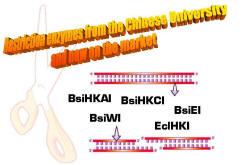 Biolabs,
Inc.and Promega Corporation in 1990s discovered in
Professor P.C. Shaw’s laboratory was among the first
technology transfer activities from CUHK. Restriction
enzymes are found in bacteria and they cleave DNA at
well-defined sites. The restriction enzymes discovered
are either heat stable or have unusual DNA recognition
sequences. They are an essential tool of many molecular
biology techniques including cloning, genotyping and
mutation analysis. They could be acquired as is or as
part of a biochemical kit.. Although the licences were
for the commercial use of some rather modest enzymes,
the transfer marked the beginning of a long and
meaningful research relationship between CUHK and
overseas commercial entities. The fact that 18 years
afterwards, CUHK is still receiving royalty from these
licenses means that the enzymes must have been put to
good use by the wider scientific and research community,
thus meeting the ultimate goal of technology transfer. Biolabs,
Inc.and Promega Corporation in 1990s discovered in
Professor P.C. Shaw’s laboratory was among the first
technology transfer activities from CUHK. Restriction
enzymes are found in bacteria and they cleave DNA at
well-defined sites. The restriction enzymes discovered
are either heat stable or have unusual DNA recognition
sequences. They are an essential tool of many molecular
biology techniques including cloning, genotyping and
mutation analysis. They could be acquired as is or as
part of a biochemical kit.. Although the licences were
for the commercial use of some rather modest enzymes,
the transfer marked the beginning of a long and
meaningful research relationship between CUHK and
overseas commercial entities. The fact that 18 years
afterwards, CUHK is still receiving royalty from these
licenses means that the enzymes must have been put to
good use by the wider scientific and research community,
thus meeting the ultimate goal of technology transfer. |
|
2. Parallel Polynucleotide
Sequencing Method |
| Developed by Prof. Wong Wing-hung, this technology
obtained a US patent in August 1999. Subsequently,
a world-renowned US biotechnology company, Affymetrix
Corporation, was granted the licence of this massively
parallel DNA sequencing technology for commercial use.
Affymetrix is known to the industry by its GeneChip
technology, a unique platform which the company intends
to establish as the pre-eminent product for acquiring,
analysing, and managing complex genetic information. |
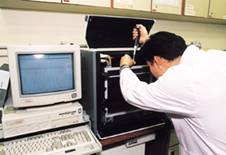 |
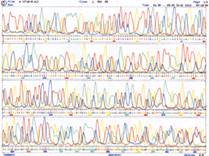 |
A
researcher of 'Parallel Polynucleotide Sequencing
Method' loading DNA samples into the sequencer |
Output
from the DNA sequencer |
|
| 3. Polymerase
Chain Reaction -- Restriction Fragment Length
Polymorphism Test for the Authentication of Traditional
Chinese Medicines |
Developed by Prof. Jun Wang, Prof. P.C. Shaw, Prof.
Paul But, and Ms. F.N. Ngan of the Department of
Biochemistry, this technology employs molecular
approaches to authenticate Chinese medicinal materials.
A US Patent was issued in March 1999. The
technology was then licensed to a local biotechnology
company, Molecular Technology Innomed Limited.
 |
An
agreement being reached between the University and
Molecular Technology Innomed Limited (MTI). From
left 2: Mr. Thomas Cheng, chairman and chief
executive officer of MTI; Mrs. Alice Yip, director
of RTAO; Prof. Jun Wang of the Department of
Biochemistry |
|
| 4. Trilex®
(三冬茶®) -- An Over-the-counter Chinese Herbal
Pharmaceutical Product |
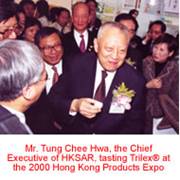 Trilex®
was jointly developed by Prof. Kong Yun Cheung and Dr.
Hu Shiu Ying of the School of Chinese Medicine and Prof.
Kwan Hoi Shan of the Department of Biochemistry with
support from the Industrial Support Fund and Tong Zhi
Tong (International) Limited. It is one of the
first Chinese herbal medicine products based on local
medicinal plants and backed up by laboratory research.
The formulation and manufacture protocols of Trilex®
were licensed to Tong Zhi Tong (International) Limited
for commercial use. Trilex®
was jointly developed by Prof. Kong Yun Cheung and Dr.
Hu Shiu Ying of the School of Chinese Medicine and Prof.
Kwan Hoi Shan of the Department of Biochemistry with
support from the Industrial Support Fund and Tong Zhi
Tong (International) Limited. It is one of the
first Chinese herbal medicine products based on local
medicinal plants and backed up by laboratory research.
The formulation and manufacture protocols of Trilex®
were licensed to Tong Zhi Tong (International) Limited
for commercial use. |
| 5. An
Associative Chinese Search Engine -- MoLi & ANSeRS® |
 Prof.
Wong Wing-shing of Department of Information Engineering
and his team first developed MoLi & ANSeRS®
in 1996. The technology won the Hong Kong Awards
for Industry in 1997, and a US Patent on the technology
was granted in May 2000. During the period, the
search engine generated substantial commercial interest
and was licenced to both local and international
licensees. Prof.
Wong Wing-shing of Department of Information Engineering
and his team first developed MoLi & ANSeRS®
in 1996. The technology won the Hong Kong Awards
for Industry in 1997, and a US Patent on the technology
was granted in May 2000. During the period, the
search engine generated substantial commercial interest
and was licenced to both local and international
licensees. |
| 6. Biometric
and SmartCard Security System |
 Developed
by Prof. Moon Yiu Sang and his research student Mr. Ng
Ka Lung, this security system is specifically designed
to address public concern on e-commerce security.
In May 2000, the system was licensed to a local
electronic giant which established a company dedicated
to the development of this technology. The project
was partly supported by the Information Technology
Entrepreneurs Association, an initiative of the HKSAR
government and local industry to nurture the development
of high technology. Developed
by Prof. Moon Yiu Sang and his research student Mr. Ng
Ka Lung, this security system is specifically designed
to address public concern on e-commerce security.
In May 2000, the system was licensed to a local
electronic giant which established a company dedicated
to the development of this technology. The project
was partly supported by the Information Technology
Entrepreneurs Association, an initiative of the HKSAR
government and local industry to nurture the development
of high technology. |
| 7. Wireless
Personal Digital Assistant (PDA) |
| This brainchild of Prof. Albert Lai of the Department
of Electronic Engineering attracted the investment of a
group of entrepreneurs in the establishment of the
company 'CyberEngineering Company Limited', which will
focus on the development of Prof. Lai's Wireless
Personal Digital Assistant. This spin-off company
is a fine example of technology transfer whereby
companies are formed based on technologies of the
University, thus creating employment opportunities and
boosting the local economy. |
| 8. Wireless
Remote Metering System |
| Prof. K.T. Chan of the Department of Electronic
Engineering developed a new generation of remote
wireless metering system with financial support from the
Industry Support Fund. The prototype system has
the ability to collect various kinds of meter data
through wireless transmission within high-rise
buildings. It will enable utility companies to
have instant access to utility consumption data and to
manage their power, gas, and water distribution networks
efficiently. This technology was licensed to a
local start-up which aims at providing ready-to-use
remote metering solutions to clients all over the world. |
| 9. Enhanced
Photocatalyst for the Improvement of Hong Kong's Air |
| The research on an enhanced photocatalyst by Prof.
Jimmy Yu of the Department of Chemistry may be a cure
for Hong Kong's deteriorating air quality. This
photocatalyst is mainly composed of titanium dioxide
which, after illumination by sunlight or near UV, can
initiate a series of chemical reactions to oxidize
common air pollutants such as volatile organic
compounds, and convert them into harmless substances.
The Environmental Protection Department of the Hong Kong
SAR Government has launched a pilot project to study how
to make use of the photocatalyst to improve the air
quality of urban areas in Hong Kong. |
| 10. Establishment of
the Centre of Cyber Logistics |
| Prof. Waiman Cheung and Prof. Lawrence Leung of the
Department of Decision Sciences and Managerial Economics
established the Centre of Cyber Logistics in 2000 to
work closely with freight forwarders, airliners,
terminal operators, the airport authority, shippers,
warehouse providers, and the government to enhance the
competitiveness of the logistics industry in Hong Kong.
The centre would study the key issues facing the air
cargo logistics industry in Hong Kong and in other
mainland cities such as Shanghai, Beijing, and
Guangzhou. It would also provide consultancy
services to the industry, one example being the
development of an optimization-simulation
network-planning methodology for an air-express courier
in Hong Kong. |
| 11. E-jing:
An Advanced 'Business to Business' E-commerce System |
Prof. Houman Yan and Prof. David Yao of the Department
of Systems Engineering and Engineering Management
jointly developed an innovative software called 'e-jing'
which enables B2B e-commerce over the Internet. 'E-jing'
is a powerful software solution allowing business
operators to integrate supply chain and revenue
management decisions into corporate procurement,
out-sourcing and sales processes. Its unique
bilingual (English and Chinese) handling capability,
together with other advanced features, make it
comparable to some of the million-dollar B2B solutions
in the market.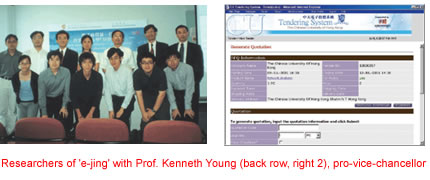 |
| 12. A Novel
Orange Fluorescent Protein from Marine Creature |
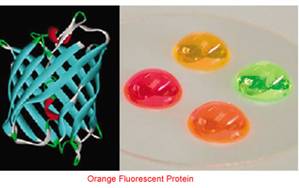 Prof.
David Wan of the Department of Biochemistry and his team
recently discovered a novel GFP-like fluorescent protein
-- the first native orange fluorescent protein ever
cloned. The protein has an emission maximum lined
at the orange colour region of the visible light
spectrum. It fits nicely into the missing spectral
gap between native green fluorescent protein GFP and
native red fluorescent protein DsRed. This cloned
polypeptide will be an extremely useful tool for
tracking and quantifying biological entities,
complementing fluorescent proteins from other sources
currently employed in the fields of biochemistry,
biotechnology, molecular biology, cell biology, and
medical diagnosis. The protein has been
commercialized by a US biotech company. Prof.
David Wan of the Department of Biochemistry and his team
recently discovered a novel GFP-like fluorescent protein
-- the first native orange fluorescent protein ever
cloned. The protein has an emission maximum lined
at the orange colour region of the visible light
spectrum. It fits nicely into the missing spectral
gap between native green fluorescent protein GFP and
native red fluorescent protein DsRed. This cloned
polypeptide will be an extremely useful tool for
tracking and quantifying biological entities,
complementing fluorescent proteins from other sources
currently employed in the fields of biochemistry,
biotechnology, molecular biology, cell biology, and
medical diagnosis. The protein has been
commercialized by a US biotech company. |
| 13. An
Intelligent On-line Monitoring System for Metal Stamping
Operations |
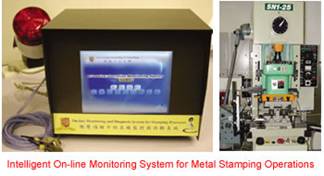 With
the support of the Innovation and Technology Fund, Miko
Manufacturing Co., Ltd. (HK), and the Hong Kong Metals
Manufacturers Association, Prof. Xu Yangsheng of the
Department of Automation and Computer-Aided Engineering
and his team developed a computer-based Stamping
Operation Monitoring System (SOMS), which is a
versatile, intelligent, and reliable on-line monitoring
system specifically designed to monitor stamping
operations of higher productivity (continuous stamping
operation with complex progressive die) and larger work
capacity (single-stroke stamping operations). SOMS
provides a cost-effective solution to the metal stamping
industry worldwide for enhancing competitiveness. With
the support of the Innovation and Technology Fund, Miko
Manufacturing Co., Ltd. (HK), and the Hong Kong Metals
Manufacturers Association, Prof. Xu Yangsheng of the
Department of Automation and Computer-Aided Engineering
and his team developed a computer-based Stamping
Operation Monitoring System (SOMS), which is a
versatile, intelligent, and reliable on-line monitoring
system specifically designed to monitor stamping
operations of higher productivity (continuous stamping
operation with complex progressive die) and larger work
capacity (single-stroke stamping operations). SOMS
provides a cost-effective solution to the metal stamping
industry worldwide for enhancing competitiveness. |
| 14. Nano-crystalline
Titanium Dioxide (TiO2) Thin Films Coating Technology
for Water Treatment |
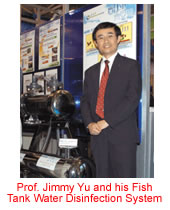 Prof.
Jimmy Yu of the Department of Chemistry extended his
research on the nano-crystalline titanium dioxide (TiO2)
thin films coating technology to water treatment by
developing a nanometer TiO2 coating technique which is
able to absorb harmful ultraviolet radiation, degrade
pollutants, and kill bacteria on contact. This
material is also anti-fogging and self-cleaning.
According to the latest experimental results, water
treatment systems equipped with Prof. Yu's nano-coating
technology possess better bactericidal activity than
conventional water treatment systems. The
technology has already been commercialized, benefiting
seafood traders and the catering industry in the main. Prof.
Jimmy Yu of the Department of Chemistry extended his
research on the nano-crystalline titanium dioxide (TiO2)
thin films coating technology to water treatment by
developing a nanometer TiO2 coating technique which is
able to absorb harmful ultraviolet radiation, degrade
pollutants, and kill bacteria on contact. This
material is also anti-fogging and self-cleaning.
According to the latest experimental results, water
treatment systems equipped with Prof. Yu's nano-coating
technology possess better bactericidal activity than
conventional water treatment systems. The
technology has already been commercialized, benefiting
seafood traders and the catering industry in the main. |
| 15. Advanced
CRM Techniques for the Banking Industry |
| Today's competitive business environment compels the
banking industry to generate more business opportunity
from existing customers. The industry collects a
colossal amount of customer data a year but such raw
data cannot be readily used for marketing or other
business activities. They have to be first
converted into meaningful information through data
cleansing, i.e. standardizing, formatting, and
classifying. Moreover, key marketing variables
such as occupation, life stage, social class are not
always directly observed, and they have to be deduced
from all available data sources for marketing actions. A team of experts in Customer Relationship Management
(CRM) in the Faculty of Business Administration
developed a set of numerical procedures and analytical
models with an aim to assist the local financial
industry in implementing CRM strategy in their
operations. The CRM technique has already been
transferred to a number of banking groups. |
| 16. Artificial
Intelligence Crime Analysis and Management System (AICAMS) |
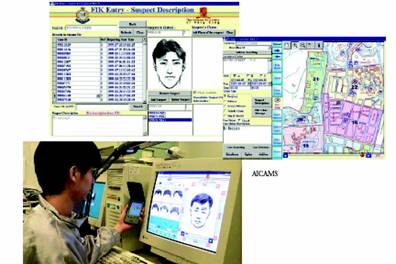
AICAMS, developed by Prof. K.P. Lam of the Systems
Engineering and Engineering Management Department, is a
collaborative research project between the Hong Kong
Police Force and the University. The
computer-based system has three key components: a
suspect look-alike tool which produces facial images
from witness descriptions; an artificial intelligence
system that produces deductions when details of a crime
are compared with its database of previous cases; and a
detailed crime map of Hong Kong where frontline officers
can see their surroundings on a computer screen together
with data on the location and nature of high-risk crime
areas. Since the initial launch of AICAMS in 1998
at the Tuen Mun District Police Headquarters, a number
of enhancements and new designs have been added to the
system. AICAMS is now implemented force-wide. |
| 17. Advanced
Surface and Materials Analysis Centre |
| Since its establishment in 1998, important progress
has been achieved by the Advanced Surface and Materials
Analysis Centre (ASMAC). Over 100 industrial
manufacturers and laboratories in Hong Kong have
benefited from its comprehensive range of expertise in
surface and materials analysis. The centre has now
obtained ISO 9000 accreditation and the HOKLAS quality
standard. The centre will be spun off, by the end
of 2003, as an independent commercial entity to be
located at the Hong Kong Science Park. ASMAC was
established by the Industrial Support Fund of the
government and 25 manufacturers. Its activities are
carried out by a team of experts from the Materials
Science and Technology Research Centre of the
University. |
| 18. Qualigenics
Centre for Diabetes and Endocrine Disorders |
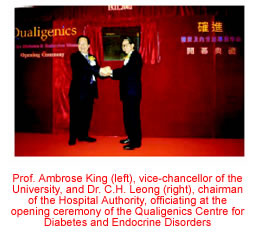 The
Qualigenics Centre for Diabetes and Endocrine Disorders
is a medical specialist clinic devoted to the total
medical management of diabetes and endocrine diseases.
It is a joint undertaking of GenRx Healthcare Ltd. (a
subsidiary of HKR International Ltd.) and the
University, with active participation by experts from
the Division of Diabetes and Endocrinology of the
Department of Medicine and Therapeutics. With the
opening of the Qualigenics Centre for Diabetes and
Endocrine Disorders, private patients are given the
choice of receiving total medical care for diabetes and
endocrine diseases provided by the medical and nursing
team of the division. Currently, Qualigenics runs
two clinics. The first clinic is located at the
School of Public Health Building at the Prince of Wales
Hospital. The second clinic is located at Pier 3,
Central, Hong Kong. The
Qualigenics Centre for Diabetes and Endocrine Disorders
is a medical specialist clinic devoted to the total
medical management of diabetes and endocrine diseases.
It is a joint undertaking of GenRx Healthcare Ltd. (a
subsidiary of HKR International Ltd.) and the
University, with active participation by experts from
the Division of Diabetes and Endocrinology of the
Department of Medicine and Therapeutics. With the
opening of the Qualigenics Centre for Diabetes and
Endocrine Disorders, private patients are given the
choice of receiving total medical care for diabetes and
endocrine diseases provided by the medical and nursing
team of the division. Currently, Qualigenics runs
two clinics. The first clinic is located at the
School of Public Health Building at the Prince of Wales
Hospital. The second clinic is located at Pier 3,
Central, Hong Kong. |
| 19. Modernization
of Traditional Chinese Medicine |
| In June 2000, the Innovation and Technology Fund and
Eu Yan Sang (Hong Kong) Ltd. provided the University
with HK$9.28 million to conduct a three-year research on
the pharmacological mechanisms underlying the beneficial
effects of Bak Foong Pills (BFP), a well known Chinese
healthcare product based on a century-old formula.
The project was undertaken by the University's
Epithelial Cell Biology Research Centre, who produced a
modified formula that has effects on oestrogenic
activity and hormonal profile, anti-hypertension, and
the restoration of immune imbalance in aging animals.
The project confirmed the beneficial effects of BFP, and
led to the development of a new formula with specific
effects on menopausal syndromes, which has been launched
in the market as Menoease.
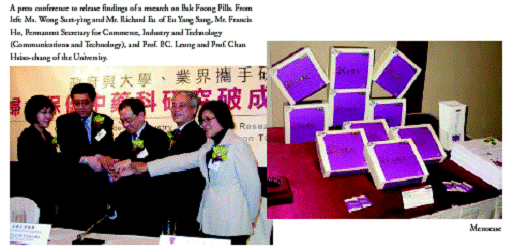 |
| 20. Novel
Input and Sensing Device – Micro Input Devices System |
 MIDS,
a novel virtual input device, is developed by Mr. Alan
Hiu-Fung Lam, a Ph.D. candidate of the Department of
Automation and Computer-Aided Engineering, and Prof. Wen
J. Li, Mr. Lam’s Ph.D. supervisor. Mr. Lam, who studied
virtual reality for his master degree, set out to
develop a virtual input device to replace traditional
computer mouse and keyboard in his Ph.D. thesis. After
two years of hard work, Mr. Lam and his team finally
developed a driver interface program that can turn even
very small hand motions into control commands. A
prototype of MIDS has been developed. The system may
have the potential to replace traditional mouse and
keyboard, and serve as a multi-functional and wearable
input device. A spin-off company was formed to further
exploit the market potential of this innovative device. MIDS,
a novel virtual input device, is developed by Mr. Alan
Hiu-Fung Lam, a Ph.D. candidate of the Department of
Automation and Computer-Aided Engineering, and Prof. Wen
J. Li, Mr. Lam’s Ph.D. supervisor. Mr. Lam, who studied
virtual reality for his master degree, set out to
develop a virtual input device to replace traditional
computer mouse and keyboard in his Ph.D. thesis. After
two years of hard work, Mr. Lam and his team finally
developed a driver interface program that can turn even
very small hand motions into control commands. A
prototype of MIDS has been developed. The system may
have the potential to replace traditional mouse and
keyboard, and serve as a multi-functional and wearable
input device. A spin-off company was formed to further
exploit the market potential of this innovative device. |
| 21. The
Research Centre for Chinese Ancient Texts
[formerly known as CHANT, CHinese ANcient Texts Centre] |
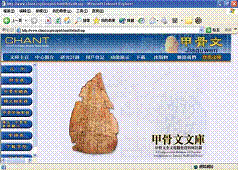 The
CHANT Centre was established in 1988 under the Institute
of Chinese Studies (ICS) of the University. Its aim was
to build an electronic database of all traditional and
excavated ancient Chinese texts, and publish them via
different media including books, software and the world
wide web. It was hoped that such a database could
provide valuable research tools for scholars, academia
and the public alike. This project has been going on for
over a decade. Since 1989, ICS has begun to establish an
electronic database of traditional ancient Chinese
texts, hoping to input all traditional texts from the
Pre-Han (pre 220 AD) period up to the Six Dynasties (581
AD), totaling over 30 million characters into the
database, and to compile concordances to these texts.
The centre started publishing ancient Chinese texts on
electronic media. In 1998, over 1,000 titles of
traditional and excavated materials have been released
through the Internet. As of July 2004, more than 25
individuals and 29 institutions worldwide have
subscribed to the database. The
CHANT Centre was established in 1988 under the Institute
of Chinese Studies (ICS) of the University. Its aim was
to build an electronic database of all traditional and
excavated ancient Chinese texts, and publish them via
different media including books, software and the world
wide web. It was hoped that such a database could
provide valuable research tools for scholars, academia
and the public alike. This project has been going on for
over a decade. Since 1989, ICS has begun to establish an
electronic database of traditional ancient Chinese
texts, hoping to input all traditional texts from the
Pre-Han (pre 220 AD) period up to the Six Dynasties (581
AD), totaling over 30 million characters into the
database, and to compile concordances to these texts.
The centre started publishing ancient Chinese texts on
electronic media. In 1998, over 1,000 titles of
traditional and excavated materials have been released
through the Internet. As of July 2004, more than 25
individuals and 29 institutions worldwide have
subscribed to the database. |
| 22. Technologies
for Reduction of Colour Pollutants in Waste Water |
| Three of the University’s patented technologies on
waste water treatment and removal of dye pollutants from
the natural environment, and recovery of industrial
products polluted by dyes have been licensed exclusively
to Bio-Treat Technology Ltd., a waste water treatment
solutions provider headquartered in mainland China. The
company specializes in using biotechnology to manage
waste. The three patented technologies, being the
backbone technology of Bio-Treat Technology Ltd., were
invented by Prof. Mark Kai Keung, a retired professor
and former chairman of the Department of Biology. The
company was successfully listed on the Mainboard of
Singapore Exchange in February 2004. |
| 23. Novel TCM-Platinum
Compounds with Antitumour Activity heading for Clinical
Development |
 A
series of novel anti-turmor agents developed by
Professor Steve AU-YEUNG of the Chemistry Department,
Professor Y P HO of the School of Pharmacy and Professor
Ge LIN of the Pharmacology Department have been licensed
to a biopharmaceutical company in mainland China which
will further advance the agents to clinical development.
The discovery of the anti-tumor agents is the result of
a decade-long research collaboration effort by the three
professors with the Dalian Institute of Chemical
Physics, The Chinese Academy of Sciences. The research
team has adopted an “East meets West” approach which
innovatively integrates a Traditional Chinese Medicine (TCM)
component with a platinum entity. Pre-clinical
experimental data shows that the new agents are
effective against a wide range of cancer cells. In
addition, the new agents are expected to eliminate
cross-resistance and induce minimal side effects. Over
the years, the novel compounds have been granted patents
in United States and China. There are also pending
patent applications in Europe, Japan and other major
countries in the world. A
series of novel anti-turmor agents developed by
Professor Steve AU-YEUNG of the Chemistry Department,
Professor Y P HO of the School of Pharmacy and Professor
Ge LIN of the Pharmacology Department have been licensed
to a biopharmaceutical company in mainland China which
will further advance the agents to clinical development.
The discovery of the anti-tumor agents is the result of
a decade-long research collaboration effort by the three
professors with the Dalian Institute of Chemical
Physics, The Chinese Academy of Sciences. The research
team has adopted an “East meets West” approach which
innovatively integrates a Traditional Chinese Medicine (TCM)
component with a platinum entity. Pre-clinical
experimental data shows that the new agents are
effective against a wide range of cancer cells. In
addition, the new agents are expected to eliminate
cross-resistance and induce minimal side effects. Over
the years, the novel compounds have been granted patents
in United States and China. There are also pending
patent applications in Europe, Japan and other major
countries in the world. |
| 24. OnMe – An
Online Game Engine Tailor-Made for the Hong Kong Digital
Entertainment Industry |
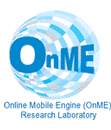 Professor
John C. S. Lui of the Computer Science and Engineering
Department has been funded by the Innovation and
Technology Fund to develop the OnMe project - Online
Mobile Engine for Creating Multi-players Online Game for
Mobile Devices. The objective of this project is to
create a new platform for designing multi-players mobile
online games for different mobile devices using the J2ME
and Symbian platform. This project has a far-reaching
benefit to many industries in Hong Kong spanning from
the movie, TV entertainment industries, to the comics,
animation industries as well as mobile operators and
mobile devices manufacturers. According to a recent
study of the Hong Kong Digital Entertainment Industry
conducted by the Hong Kong Productivity Council, most
companies in the digital entertainment industry in Hong
Kong are young SMEs, and they lack the information or
resources to locate and access support services which is
vital to their development. Soon after a prototype of
the game engine was developed, a local game developer
acquired a licence from the University to use the game
engine for their online game development. It is
expected that the OnMe project will significantly
enhance the online game development capability of the
Hong Kong Digital Entertainment Industry. Professor
John C. S. Lui of the Computer Science and Engineering
Department has been funded by the Innovation and
Technology Fund to develop the OnMe project - Online
Mobile Engine for Creating Multi-players Online Game for
Mobile Devices. The objective of this project is to
create a new platform for designing multi-players mobile
online games for different mobile devices using the J2ME
and Symbian platform. This project has a far-reaching
benefit to many industries in Hong Kong spanning from
the movie, TV entertainment industries, to the comics,
animation industries as well as mobile operators and
mobile devices manufacturers. According to a recent
study of the Hong Kong Digital Entertainment Industry
conducted by the Hong Kong Productivity Council, most
companies in the digital entertainment industry in Hong
Kong are young SMEs, and they lack the information or
resources to locate and access support services which is
vital to their development. Soon after a prototype of
the game engine was developed, a local game developer
acquired a licence from the University to use the game
engine for their online game development. It is
expected that the OnMe project will significantly
enhance the online game development capability of the
Hong Kong Digital Entertainment Industry. |
| 25. The
World’s Smallest Bluetooth Enabled LTCC Module Ready for
Commercial Exploitation |
|
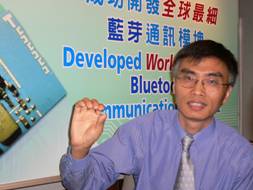 Professor
Ke-Li WU of Dept of Electronic Engineering and his
research team have successfully developed the world's
smallest Bluetooth™ communication module under the
support from the Innovation and Technology Fund (“ITF”).
This integrated module is based on the Low Temperature
Co-fired Ceramic (LTCC) technology. All the required
passive Radio Frequency (RF) functional circuits,
particularly balance-to-unbalance transformer (Balun),
matching network, bandpass RF filter and antenna, are
embedded into a 12-layer ceramic substrate in a 3-D
fashion. The size of the module is 12 by 12 by 1 mm3
which is less than half the size of commercial modules
available in the market. This patent-pending module
requires much fewer surface mounted components, and
could be applied to any Bluetooth™ enabled consumer
wireless products including mobile phone headset, laptop
computer, MP3 players and digital cameras. A number of
companies have already shown interest in launching
commercial Bluetooth™ modules based on Professor Wu’s
innovation. Professor
Ke-Li WU of Dept of Electronic Engineering and his
research team have successfully developed the world's
smallest Bluetooth™ communication module under the
support from the Innovation and Technology Fund (“ITF”).
This integrated module is based on the Low Temperature
Co-fired Ceramic (LTCC) technology. All the required
passive Radio Frequency (RF) functional circuits,
particularly balance-to-unbalance transformer (Balun),
matching network, bandpass RF filter and antenna, are
embedded into a 12-layer ceramic substrate in a 3-D
fashion. The size of the module is 12 by 12 by 1 mm3
which is less than half the size of commercial modules
available in the market. This patent-pending module
requires much fewer surface mounted components, and
could be applied to any Bluetooth™ enabled consumer
wireless products including mobile phone headset, laptop
computer, MP3 players and digital cameras. A number of
companies have already shown interest in launching
commercial Bluetooth™ modules based on Professor Wu’s
innovation. |
| 26. A
Patented Method for Extracting APG, an Active Ingredient
of Yunzhi |
|
Yunzhi has long been used by the Chinese to enhance
the immune system. As proven by scientific
research, the most recognized active ingredient in
Yunzhi is polysaccharide, which cannot be effectively
absorbed by the human intestine. Research conducted by
Professor Albert Chow and his Ph.D. student Dr. Kevin
Chu of the School of Pharmacy has led to the discovery
of absorbable peptidoglucan (APG), a novel active
ingredient in Yunzhi that can be readily absorbed by the
human intestine and is effective in stimulating the
immune system. Professor Chow also developed a
proprietary extraction method to enable APG to be
retained in large quantities in the Yunzhi extract.
The invention, which has been granted a US Patent, was
licensed to a health supplement manufacturer, which also
appointed Dr. Kevin Chu as its R&D Manager. Oncozac™, a
product based on the proprietary extraction method, has
been launched in the market. |
| 27. A
Proprietary Natural Product for Treating Insomnia |
|
Insomnia is the most common sleep disorder nowadays
requiring appropriate recognition and management.
Because of the side-effects commonly associated with
conventional drugs, herbal and other natural sleep aids
are gaining popularity. However, most of the natural
products available are herbal mixtures with very little
understanding on their action mechanisms, and thus few
are proprietary products. With the support from the
Innovation and Technology Fund and Bright Future
Pharmaceutical Laboratories Ltd, Professor CHAN Hsiao
Chang of the Epithelial Cell Biology Research Centre and
her research team has developed a proprietary natural
alternative product for insomnia and other sleep related
disorders. Professor Chan has employed a number of new
and innovative techniques, such as molecular and cell
biological techniques and electrophysiology in
combination with chemical analysis, in verifying the
effect of the herb. A product based on the scientific
study has been launched in the market by Bright Future
Pharmaceutical Laboratories Ltd. |
| 28. GengShuAn Granule as
Alternative of Estrogen Replacement Therapy |
|
Estrogen Replacement Therapy (ERT) is a common therapy
for postmenopausal women suffering menopausal syndrome.
It however is proven to increase incident of breast and
ovary cancer, coronary diseases, stroke and pulmonary
embolism. With the support from the Hong Kong Jockey
Club Institute of Chinese Medicine (HKJCICM), Professor
Jun Wang of the Biochemistry Department and Professor
Hui Yong Zheng of the Shanghai Innovative Research
Center of Traditional Chinese Medicine has developed
GengShuAn Granule, a Fu fang Chinese medicine, based on
an ancient prescription for relieving menopausal
syndrome. The research team aims at submitting a new
drug application to the State Food & Drug Administration
(SFDA) of P R China for the new formula. |
|
29. A New Platform
for Non-invasive Prenatal Diagnosis |
|
The University has
licensed to Sequenom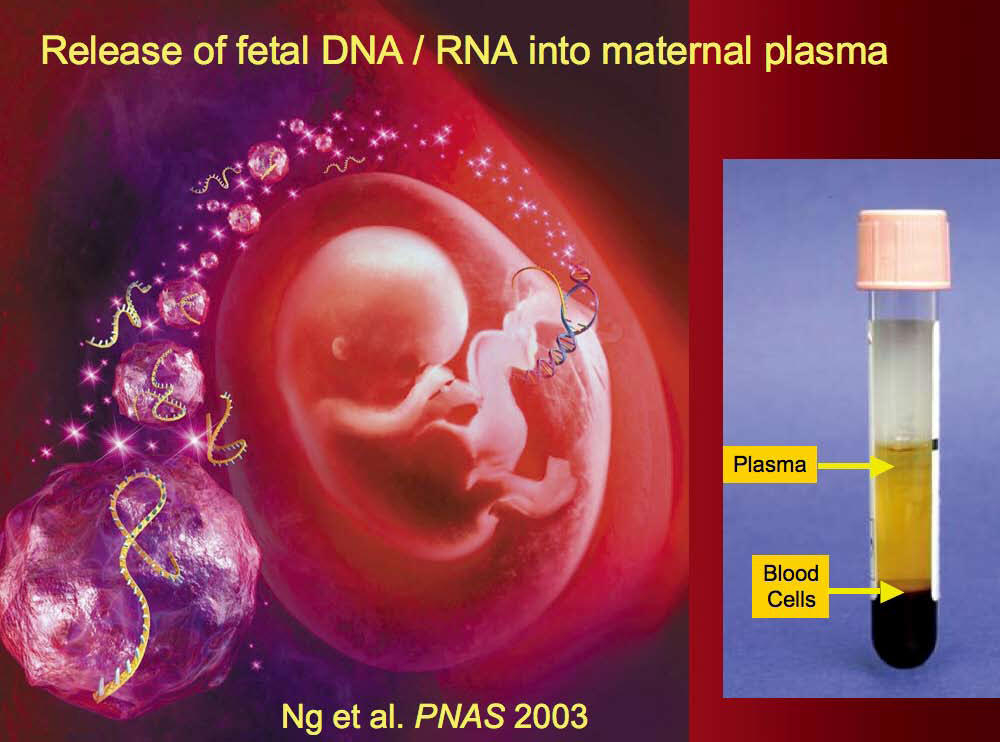 ,
a US listed biotech company a series of patent rights
related to non-invasive prenatal genetic analysis
methods using fetal nucleic acids obtained from maternal
serum or plasma. The technologies are developed by
Professor Dennis Y. M. Lo of the Chemical Pathology
Department and his research team. Professor Lo first
discovered in 1997 that an unborn fetus will release its
DNA into the plasma of a pregnant woman. This finding
has opened up a new approach of non-invasive prenatal
diagnosis. There are a number of fetal maternal
disorders that affect the mother and the fetus
throughout the pregnancy period. These diseases include
RhD blood group incompatibilities, Down Syndrome (Trisomy
21), Trisomy 18 and Thalassemia. However, the current
tests for these disorders have the undesirable drawbacks
of miscarriage and the absence of definitive diagnosis
for prenatal condition. The CUHK technology answers the
dream of physicians and expectant parents for a prenatal
test that is specific, sensitive, non-invasive and
affordable. Over the last few years, the CUHK team has
published a number of significant advances in the top
biomedical journals, including the New England Journal
of Medicine, the Lancet, Nature Medicine, the
Proceedings of the National Academy of Sciences
(U.S.A.). The team’s work has also been featured
prominently in the 2 September 2005 issue of Science.
This is an example demonstrating the world class status
of research at the University as well as how
industry-university collaboration can work hand in hand
for the benefit of mankind. ,
a US listed biotech company a series of patent rights
related to non-invasive prenatal genetic analysis
methods using fetal nucleic acids obtained from maternal
serum or plasma. The technologies are developed by
Professor Dennis Y. M. Lo of the Chemical Pathology
Department and his research team. Professor Lo first
discovered in 1997 that an unborn fetus will release its
DNA into the plasma of a pregnant woman. This finding
has opened up a new approach of non-invasive prenatal
diagnosis. There are a number of fetal maternal
disorders that affect the mother and the fetus
throughout the pregnancy period. These diseases include
RhD blood group incompatibilities, Down Syndrome (Trisomy
21), Trisomy 18 and Thalassemia. However, the current
tests for these disorders have the undesirable drawbacks
of miscarriage and the absence of definitive diagnosis
for prenatal condition. The CUHK technology answers the
dream of physicians and expectant parents for a prenatal
test that is specific, sensitive, non-invasive and
affordable. Over the last few years, the CUHK team has
published a number of significant advances in the top
biomedical journals, including the New England Journal
of Medicine, the Lancet, Nature Medicine, the
Proceedings of the National Academy of Sciences
(U.S.A.). The team’s work has also been featured
prominently in the 2 September 2005 issue of Science.
This is an example demonstrating the world class status
of research at the University as well as how
industry-university collaboration can work hand in hand
for the benefit of mankind.
|
For further queries, please contact:
Ms Alice Ngan
Director
Technology Licensing Office
The Chinese University of Hong Kong
Room 328, Pi Ch’iu Bldg Tel: (852) 2609 8883
Shatin, New Territories Fax: (852) 2603 5451
Hong Kong SAR Email: alicengan@cuhk.edu.hk |
